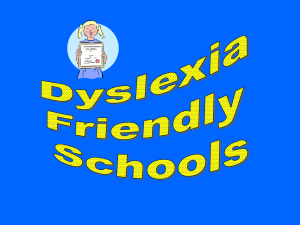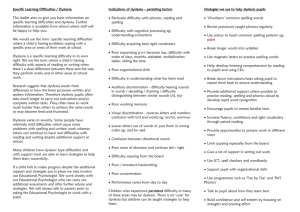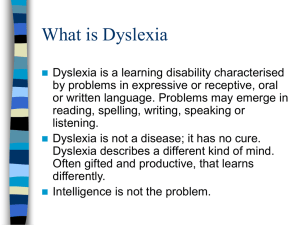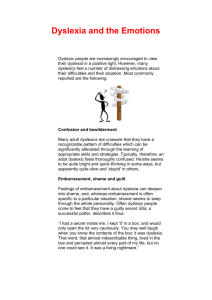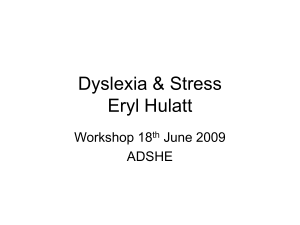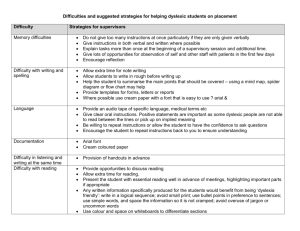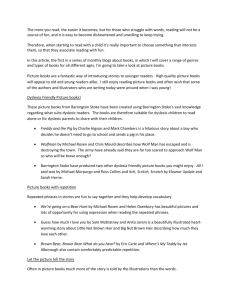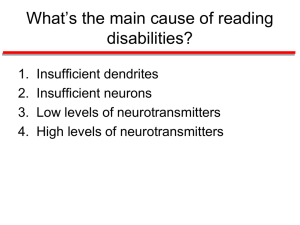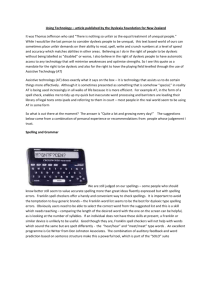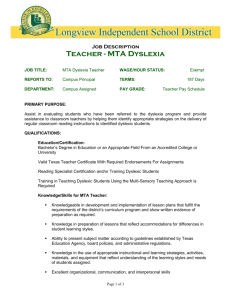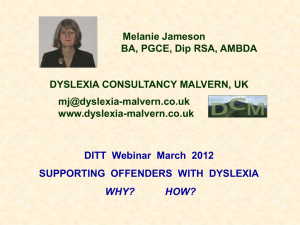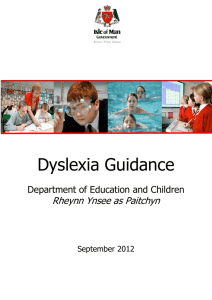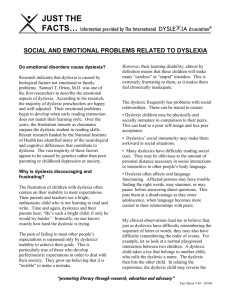Word Version - Andorra Pediatrics
advertisement
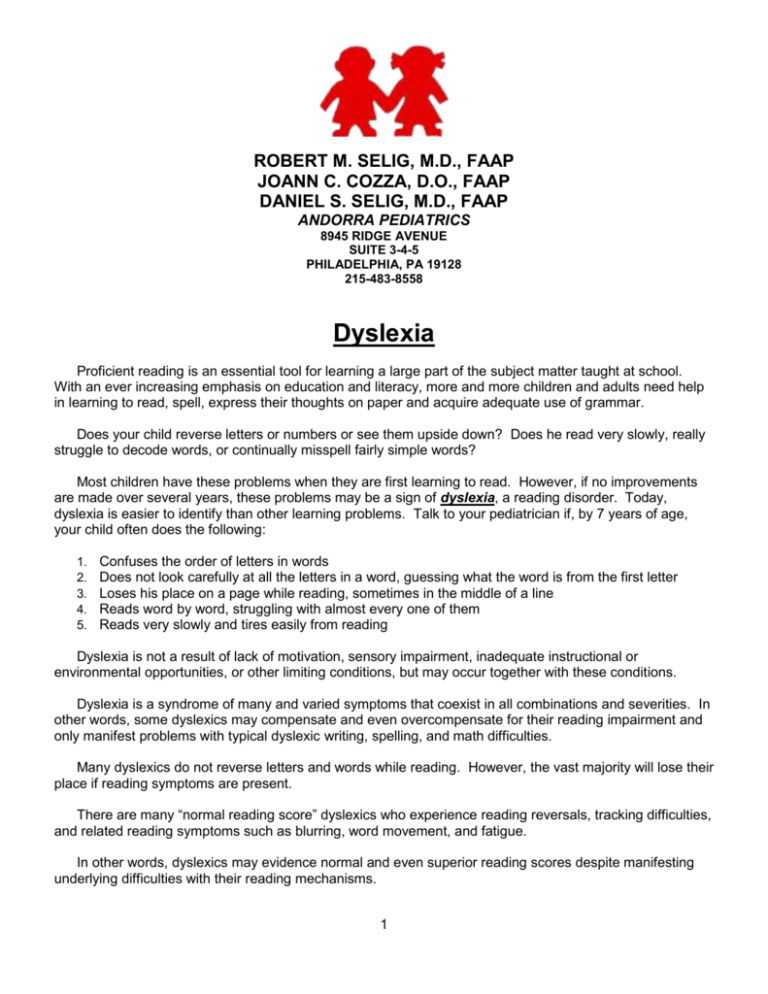
ROBERT M. SELIG, M.D., FAAP JOANN C. COZZA, D.O., FAAP DANIEL S. SELIG, M.D., FAAP ANDORRA PEDIATRICS 8945 RIDGE AVENUE SUITE 3-4-5 PHILADELPHIA, PA 19128 215-483-8558 Dyslexia Proficient reading is an essential tool for learning a large part of the subject matter taught at school. With an ever increasing emphasis on education and literacy, more and more children and adults need help in learning to read, spell, express their thoughts on paper and acquire adequate use of grammar. Does your child reverse letters or numbers or see them upside down? Does he read very slowly, really struggle to decode words, or continually misspell fairly simple words? Most children have these problems when they are first learning to read. However, if no improvements are made over several years, these problems may be a sign of dyslexia, a reading disorder. Today, dyslexia is easier to identify than other learning problems. Talk to your pediatrician if, by 7 years of age, your child often does the following: 1. 2. 3. 4. 5. Confuses the order of letters in words Does not look carefully at all the letters in a word, guessing what the word is from the first letter Loses his place on a page while reading, sometimes in the middle of a line Reads word by word, struggling with almost every one of them Reads very slowly and tires easily from reading Dyslexia is not a result of lack of motivation, sensory impairment, inadequate instructional or environmental opportunities, or other limiting conditions, but may occur together with these conditions. Dyslexia is a syndrome of many and varied symptoms that coexist in all combinations and severities. In other words, some dyslexics may compensate and even overcompensate for their reading impairment and only manifest problems with typical dyslexic writing, spelling, and math difficulties. Many dyslexics do not reverse letters and words while reading. However, the vast majority will lose their place if reading symptoms are present. There are many “normal reading score” dyslexics who experience reading reversals, tracking difficulties, and related reading symptoms such as blurring, word movement, and fatigue. In other words, dyslexics may evidence normal and even superior reading scores despite manifesting underlying difficulties with their reading mechanisms. 1 If one or more of the following symptoms are evident, dyslexia may be present: 1. 2. 3. 4. 5. 6. Reading Memory instability for letters, words, or numbers. A tendency to skip over or scramble letters, words, and sentences. A poor, slow, fatiguing reading ability prone to compensatory head tilting, near-far focusing, and finger pointing. Reversals of letters such as b and d, words such as saw and was, and numbers such as 6 and 9 or 16 and 61. Letter and word blurring, doubling, movement, scrambling, omission, insertion, size change, etc. Poor concentration, distractibility, light sensitivity (photophobia), tunnel vision, delayed visual and phonetic processing, etc. Writing Messy, poorly angulated, or drifting handwriting prone to size, spacing, and letter-sequencing errors. Spelling, Math, Memory, and Grammar Memory instability for spelling, grammar, math, names, dates, and lists, or sequences such as the alphabet, the days of the week and months of the year, and directions. Speech Speech disorders such as slurring, stuttering, minor articulation errors, and poor word recall, and auditory-input and motor-output speech lags. Right/left and related directional uncertainty. Delay in learning to tell time. Concentration and Activity Impaired concentration, distractibility, hyperactivity, or over activity Balance and Coordination Difficulties with balance and coordination functions, i.e., walking, running, skipping, hopping, tying shoelaces, and buttoning buttons. Psychosomatic Complaints Difficulties with headaches, nausea, dizziness, vomiting, motion sickness, abdominal complaints, excessive sweating, and bedwetting. Self-Esteem Feeling stupid, ugly, incompetent, and brainless. 1. 2. 3. 4. Phobias and Related Mood and Obsessive/Compulsive Disorders Fears of the dark, heights, getting lost, going to school. Fear or the avoidance of various balance, coordination, sports, and motion-related activities. Mood disturbances. Obsessions and compulsions. Direction Time Helping Your Child With Dyslexia Although dyslexia is life long, individuals with dyslexia frequently respond successfully to timely and appropriate intervention. A dyslexic child who finds the acquisition of these literacy skills difficult can also suffer a lot of anguish and trauma when they may feel mentally abused by their peers within the school environment, because they have a learning difficulty. Much can be done to alleviate this by integrating the child into the class 2 environment (which is predominantly a learning environment) where he/she can feel comfortable and develop confidence and self esteem. Class teachers need to have an understanding of the problems that the dyslexic child may have within the classroom situation. Hopefully, with this knowledge, a great deal of misunderstanding of a child's behavior can be prevented. In a positive and encouraging environment, a dyslexic child will experience the feeling of success and self-value. Of particular importance is an understanding of the problems that poor auditory short term memory can cause, in terms of retaining input from the teacher. Examples of poor auditory short term memory can be a difficulty in remembering the sounds in spoken words long enough to match these, in sequence, with letters for spelling. Often children with poor auditory short term memory cannot remember even a short list of instructions Below are some excerpts from Patricia Hodge’s article: Helping In the Class An understanding of the pupil's specific difficulties, and how they may affect the student's classroom performance, can enable the teacher to adopt teaching methods and strategies to help the dyslexic child to be successfully integrated into the classroom environment. Seat the child fairly near the class teacher so that the teacher is available to help if necessary, or he can be supported by a well-motivated and sympathetic classmate. Make a daily check list for the pupil to refer to each evening. Encourage a daily routine to help develop the child's own self-reliance and responsibilities Encourage good organizational skills by the use of folders and dividers to keep work easily accessible and in an orderly fashion. Break tasks down into small easily remembered pieces of information. If visual memory is poor, copying must be kept to a minimum. Notes or handouts are far more useful. Approach to Reading A structured reading scheme that involves repetition and introduces new words slowly is extremely important. This allows the child to develop confidence and self esteem when reading. Don't ask pupils to read a book at a level beyond their current skills, this will instantly demotivate them. Motivation is far better when demands are not too high, and the child can actually enjoy the book. If he has to labor over every word, he will forget the meaning of what he is reading. Real books should also be available for paired reading with an adult, which will often generate enthusiasm for books. Story tapes can be of great benefit for the enjoyment and enhancement of vocabulary. No child should be denied the pleasure of gaining access to the meaning of print even if he cannot decode it fully. Approach to Spelling Many of the normal classroom techniques used to teach spellings do not help the dyslexic child. All pupils in the class can benefit from structured rules and patterns that underpin a language. Dyslexics seem to be unable to correct their spellings spontaneously as they write, but they can be trained to look out for errors that are particular to them. Remember, poor spelling is not an indication of low intelligence. Approach to Handwriting Reasons for poor handwriting at any age can be poor motor control, tension, badly formed letters, and writing too fast. If handwriting practice is needed, it is essential to use words that present no problem to the dyslexic child in terms of meaning or spelling. Improvement in handwriting skills can improve self confidence, which in turn reflects favorably throughout a pupil's work. 3 Approach to Homework By the end of a school day a dyslexic child is generally more tired than his peers because everything requires more thought, tasks take longer and nothing comes easily. More errors are likely to be made. Only set homework that will be of real benefit to the child. In allocating homework and exercises that may be a little different or less demanding, it is important to use tact. Self-esteem is rapidly undermined if a teacher is underlining the differences between those with difficulties and their peers. However, it should also be remembered that far more effort may be needed for a dyslexic child to complete the assignment than for their peers. Set a limit on time spent on homework, as often a dyslexic child will take a lot longer to produce the same work that another child with good literacy skills may produce easily. When homework is set, it is important to check that the child correctly writes down exactly what is required. Try to ensure that the appropriate worksheets and books are with the child to take home. Conclusion Dyslexics have many strengths, oral skills, comprehension, good visual spatial awareness/artistic abilities. More and more dyslexic children could become talented and gifted members of our schools if we worked not only with their specific areas of difficulty, but also their specific areas of strengths from an early age. To do this we have to let go of outmoded viewpoints that a dyslexic child must first fail, in order to be identified. Class teachers dealing with dyslexic children need to be flexible in their approach, so that they can, as far as possible, find a method that suits the pupil, rather than expecting that all pupils will learn in the same way. Above all, there must be an understanding from all who teach them, that they may have many talents and skills. Their abilities must not be measured purely on the basis of their difficulties in acquiring literacy skills. Dyslexic children, like all children, thrive on challenges and success A Dyslexic Child in the Classroom by Patricia Hodge http://www.dyslexia.com/library/classroom.htm Understanding the Dyslexia Syndrome Harold N, Levinson, M.D. Director, Medical Dyslexic Treatment Center http://www.dyslexiaonline.com **Some of the above information was adapted from Dr. Levinson and Patricia Hodge’s articles 4
